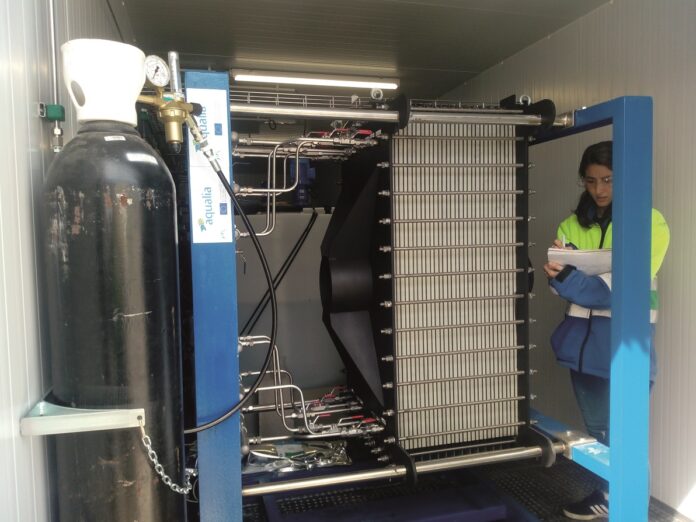Jac van Tuijn talks to Sergio Salinas about prospects for use of microbial desalination cells, the focus of a book published by IWA Publishing.
While established approaches to seawater desalination, such as reverse osmosis, require considerable amounts of energy, microbial electrochemical technology harnessed in microbial desalination cells (MDCs) has the potential to reduce these energy needs. Development of MDC technology is at an early stage, but it has the potential to use 40% less energy compared with reverse osmosis.
This view is supported by experience from the first scaled-up demonstration plants in Spain, which are producing drinking water. This is covered in the book Microbial Desalination Cells for Low Energy Drinking Water, published last year by IWA Publishing. It describes the recent development of MDC technology to produce drinking water from brackish and sea water. The authors included the latest insights from the EU MIDES research project.
Sergio Salinas, associate professor at IHE Delft Institute for Water Education, is one of the co-authors of the book and was involved in the scale-up. He explains that, from 2016-21, a consortium of 10 academic institutes, laboratories and companies worked to scale up MDC technology from laboratory tests to demonstration scale. The consortium built two plants: one for the production of drinking water from brackish water (in Denia, Spain) and one for the production of drinking water from seawater (in Guı´a de Isora, Tenerife, Spain).
The plant in Denia became operational in November 2019, producing 150 m3/h of desalinated water with less than 0.5 kWh/m3 of energy use. The plant in Tenerife became operational in 2021. Both demonstration plants are operated by Aqualia and data is being collecting to support further developments in the technology. A patent was awarded to the project partners, Aqualia and IMDEA, in 2020.
Optimising microbial capacity
An attribute of the MDC cell is the presence of specific types of bacteria, clustered on electrodes, which are used to produce the electrical current. The electrodes are separated by ion-exchange membranes. This generates an ion-exchange process that desalinates salty water. The development of this technology is described in detail in the book. This includes the exploration of numerous paths of development to enable the microbes to produce more electrical current without having to build huge cells. One such path is the use of different materials for the electrodes, helping the microbes to attach to the surface.
Another area of research was feeding microbes with nutrients from wastewater. A cell was built for salty feed water and wastewater – with each water feed kept separate – with only the nutrients able to get to the microbes. An additional effect of this nutrient uptake is the cleaning of the wastewater, making MDC a combined technology for desalination and wastewater treatment.
Low energy demand
Next to the redesign of the cell, the MIDES research focused on the overall reduction of the energy demand. A large contributor was the use of ceramic membranes as a pre-treatment. These ceramic membranes can be cleaned easily, resulting in less fouling and a performance at low energy demand of less than 0.1 kWh/m3.
The next part of the process uses a MDC cell, which reduces the salt concentration further, using the electrical current from the microbes. In these two steps, the salt concentrations are reduced from 35,000 mg/l in the feed water to 5000 to 10,000 mg/l. This remaining flow is comparable to brackish water and is finally turned into drinking water by reverse osmosis (RO). Because of the lower salt concentration, this final RO step uses far less energy. In total, the MDC process uses 0.5 kWh/m3, compared with the typical 3-4 kWh/m3 for the widely used seawater RO process.
Less complex
“We are continuously researching ways to improve the sustainability of desalination systems,” says co-author Salinas. “MIDES made a big contribution here by achieving a low energy process. Especially if you regard the reduction of carbon dioxide emissions and climate change. The research project not only broke the energy barrier for desalination, but it also included the treatment of wastewater, which reduces the further pollution of oceans.”
IHE Delft was responsible for the life-cycle analysis of the whole treatment system. Salinas explains: “We monitored to improve the whole life-cycle, not only the improvement of the technology itself.”
According to Salinas, the MIDES project managed to overcome existing limitations of the MDC technology, such as low desalination rates, high manufacturing costs, biofouling of membranes, optimisation of the microbial electrochemical process, system scale-up and the economic feasibility of the technology.
Salinas says: “The low energy consumption is an important achievement. Now the challenge is to make the technology more robust and to change the operational mode from batch to continuous treatment.”
Promising combination
Salinas believes MDC is a promising new desalination technology, although it will be hard to compete with Sea Water Reverse Osmosis (SWRO). “A cubic metre of drinking water produced with SWRO costs less than 1 Euro/m3 ,” he explains. “We lack data to compare a full-scale MDC plant to a full-scale SWRO plant, but it will be difficult to desalinate water at a lower price.”
Because of the combination of drinking water production with wastewater treatment, Salinas thinks there will be interesting opportunities in remote coastal areas. “MDC technology is not new,” he says. “In combination with other water treatment technologies, it has made remarkable developments in the application for desalination.
“SWRO is still the best available technology, but it is always interesting to have additional solutions for specific circumstances. The combination with wastewater treatment is an interesting option for remote areas. This could be a niche market that could be developed.”
More information
Microbial Desalination Cells for Low-Energy Drinking Water, Salinas-Rodriguez, et al, 2021, ISBN: 9781789062113.
www.iwapublishing.com








